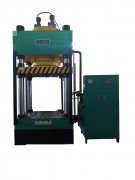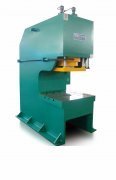How to Program Hydraulic Press Automation Systems
time:2023-03-13 views:(点击 949 次)Hydraulic presses are powerful machines that can tackle a range of difficult tasks. Unfortunately, they require manual intervention to operate effectively and slowly.
Automating hydraulic presses makes them more productive and flexible, improving workflow in busy laboratories while increasing accuracy by eliminating human error.
Inductive Sensors
Inductive sensors are a popular and reliable sensor type used in machineries. They can be employed for position sensing, contactless wheel speed sensing, and many other tasks.
In a typical sensor, an induction loop or detector coil consists of multiple turns of insulated magnet wire wrapped around a high magnetic permeability core. This is connected to capacitance in order to form a tuned frequency oscillator tank circuit which is then controlled by either voltage or current gain devices such as transistors.
When metal targets come into contact with the sensor, it causes oscillation inside of the sensing head. This is then monitored by another subcircuit which regulates output.
These sensors can distinguish between metallic and non-metallic objects, while remaining insensitive to vibration, dust, and moisture.
Utilizing inductive proximity sensors in your hydraulic press automation system will enable you to monitor tool change procedures and prevent premature tool release. This helps reduce production faults, minimize downtime, and save on costs.
For this application, Contrinex's C44 series of inductive sensors are an ideal choice because they offer uncompromising accuracy, superb dependability and an affordable price point. Plus, they come in various sizes to meet all your requirements.
PLC Programming
PLC Programming is the ability to write a computer program that controls an industrial machine with the aid of a programmable controller. These devices are utilized for controlling motors, sensors, machines and many other industrial processes.
Programming a PLC involves entering the program code into software running on a PC. Once complete, this code is downloaded to the PLC hardware for execution.
Depending on the manufacturer, several programming languages can be employed to program a PLC. These include Ladder Logic (LD), Function Block Diagram (FBD), Structured Text (ST), Instruction List (IL) and Sequential Function Chart (SFC).
Another essential step of the process is input scanning. This enables the PLC to save its current ON/OFF state, avoiding abrupt changes that could disrupt your program.
The input scan also enables programmers to test their PLC by programming it to run simulated versions of the machine. This eliminates the need for I/O hardware during testing, saving time and labor in the process.
Once a PLC has been programmed and configured with all necessary inputs and outputs, it can be put in Run mode to continue working as programmed. It then integrates with other hardware on the machine such as sensors, pneumatic valve banks, robotics or HMIs (Human Machine Interface - touchscreen interfaces). Programming plays an integral role in ensuring successful and safe operation of hydraulic press automation systems.
Locon Sensor Systems Inc.
Are you searching for a sensor company that can program hydraulic press automation systems? Look no further than Locon Sensor Systems Inc. Their extensive range of sensors includes photoelectric, inductive proximity, capacitive and high temperature options. They offer cables, connectors and cable assemblies as well as custom sensors tailored to meet your requirements. Their products are used in industrial manufacturing and automotive applications as well as dental and medical settings. They possess extensive expertise in working with customers to find the best solutions for their individual requirements. Furthermore, they offer technical support such as repair or rebuilding sensors when necessary. Get in touch today to discover more about their capabilities and how they can assist you; having been established since 1987.
Link to this article: https://www.ihydraulicpress.com/ht/1590.html
Hot Articles
-
How to Choose a Hydraulic Press Automation System Repair Company
If you own or operate a hydraulic press, you may be uncertain how to select the best repair service company. Doing so can help save you money on c……
-

How do hydraulic press manufacturers install and debug hydraulic presses?
How do hydraulic press manufacturers install and debug molds? When the hydraulic press is put into use, the hydraulic press manufacturer needs to in……
-
Disadvantages of Hydraulic Press Automation Systems
Hydraulic press automation systems are an invaluable asset to stamping manufacturers. They make it simpler and faster to produce parts with higher q……
-
How to Make a Coin Using a Hydraulic Press
Hydraulic presses play an integral part in many manufacturing and production processes. From creating machine components to compacting waste and ref……
-
Hydraulic Press Repairs
Hydraulic presses are essential tools in many industries, helping operators fit and bend sheet metal, parts, bearings and equipment to perfection.……
-
The Advantages of Hydraulic Press Automation Systems
Hydraulic presses are essential tools in many industries that require precise control and accuracy. Unfortunately, the failure of a hydraulic pres……
-
Advantages of Hydraulic Press Tooling
Hydraulic press tooling enables users to perform an array of operations. These include cutting, bending, forming, drawing, punching, coining and p……
-
The Benefits of Hydraulic Press Tooling
Hydraulic presses are an ideal choice for metalworking companies looking to maximize productivity and efficiency. Compared to mechanical presses, ……
Latest News
-
Benefits of Hydraulic Press Automation
Hydraulic press automation systems not only increase production productivity, but they also cut maintenance costs and downtime. Furthermore, these……
-
Hydraulic Press Tooling Repair Cost
Operators of hydraulic presses must always double-check their tooling, particularly its back gauge and stop finger accuracy, for quality assurance p……
-
What Is a Large Hydraulic Press?
A large hydraulic press is a machine that utilizes compressed fluid to generate the force necessary to bind items together, bend metal parts and h……
-
Safety Procedures For Using a Hydraulic Press
When working with hydraulic presses, there are some essential safety protocols that all employees should abide by. These include knowing the machi……
-
Benefits of Hydraulic Press Tooling
Hydraulic press tooling offers several advantages for your manufacturing process. They feature customizable features, built-in overload protection……
-
Hydraulic Press Automation Systems
Hydraulic presses are common tools of the trade in many industries for assembly and maintenance tasks. They operate by applying pressure through a……
-
Hydraulic Press Repair
Hydraulic presses can experience various issues over time. These issues may affect their performance and lead to significant downtime for customer……
-
How to Troubleshoot Hydraulic Press Issues
Hydraulic presses are a useful tool for deforming and milling materials. They’re often employed in the automotive industry to fabricate body ……















































